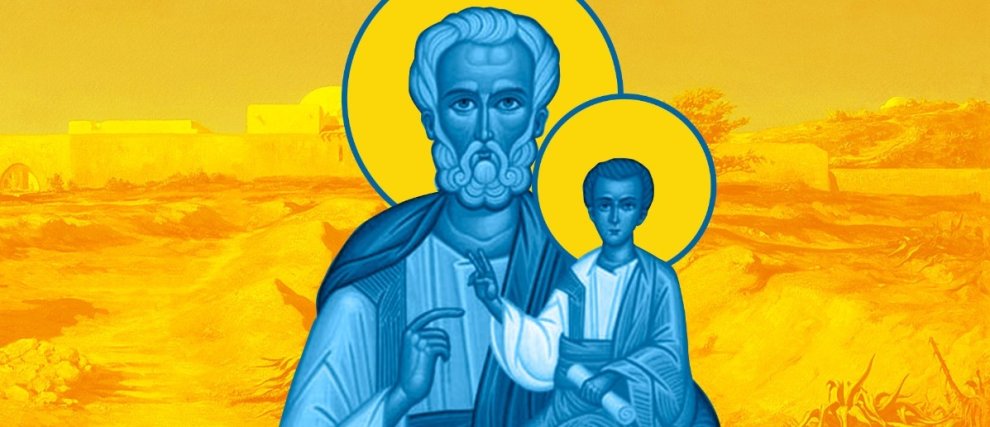Guide to Saints
Although it may seem simple, the word saint is used in many ways and is associated with many aspects of our lives. It appears in the names of some places, like Saint Petersburg in Russia, or even the famous city of San Francisco is also attributed to a saint: its name comes from the Spanish translation of Saint Francis of Assisi.
The word “Saint” can be used to organize our daily life—on our calendars, we sometimes watch for the saint of the day. But who are the saints, for us Christians? What do they have to teach us? Through this guide, delve deeper into the mystery of holiness, and discover many exciting and inspiring lives of saints!
What is a Saint?
No surprise here, the word saint comes from religion. Holiness is the quality of saints, a concept that applies to objects (the Holy Bible, the Holy Shroud) as well as to abstract notions (the Holy Spirit, the rite of the Holy Sacrament) and to men. The word “saint” comes from the Latin sanctus, and is translated into Greek as hagios (we call the biography of a saint a “hagiography”). The word refers to that which is venerable, sacred, and pure, bringing us closer to God.
Touched by grace and filled with virtue, the saints dedicate their lives to fully following the word of Christ. However, a saint is no superhero. Let us say instead that the saints play the role of models for their brothers and sisters. Martyrs, kings, monks, nuns, rich, poor, men, women... regardless of their origins, saints are all examples of lives fully given to Christ and others. They are the image of the heavenly promise on Earth, and that is why we can ask them to intercede for us. When we ask for the intercession of the saints in our prayer, we believe that they can bring our intentions before God, whether for us, our loved ones, for the Church, or for the world.
“You are to be holy to me because I, the Lord, am holy, and I have set you apart from the nations to be my own.” (Leviticus 20:26)
Who is Holy?
Well, for starters, God is holy! More than that, God is holiness.
“Holy is the Lord, God of the
Hozana universe in highest heaven!”
But each one of us is also called to holiness. It is the vocation of every baptized person, and it is within our reach! It is not necessary to be a priest, nun, or to be endowed with an extraordinary gift of healing or prophecy in order to be holy. Whatever our age and state of life, to be holy is to seek to fulfill the will of God where we are, here and now. It is living our life with Him, loving Him and loving the people He puts on our path, no longer living centered on ourselves and our pride but centered on Him and His will. It is not always easy, and following the example of others can sometimes help us to advance on this path to holiness. The charity shown by a grandmother or a friend, can sometimes particularly touch and strengthen us. The experience of Blessed Chiara Luce or Saint Therese of Lisieux can also speak to us and inspire us!
But, if everyone can be holy, why is the name “saint” given only to certain people? From an official point of view, the worship of saints is practiced by the Catholic and Orthodox branches of Christianity. Thus, holy persons as we know them have been officially recognized as such by the Church, following a long process of codified canonization since the tenth century. In addition, several stages precede canonization: the person must first be recognized as venerable, then as blessed (following a process of beatification), and can then, or not, be declared holy. Be careful, this obviously does not mean that the Church considers only those who are officially canonized to be holy! It knows well that for God, who knows all hearts, many other people are holy, but she must be careful and set up as examples of Christian perfection only people of whom a very large number of testimonies and elements testify of holiness.
Diversity and Number of the Saints of God
There are many saints, from the earliest days of Christianity to the present day. They have followed many paths, some more arduous than others. Each in their own way, they always served and loved God and their neighbors. Check out these great examples for inspiration!
The Saints Who Made the Church: Saints of the First Era, Fathers and Doctors of the Church, Canonized Popes
Among the saints, there are those who accompanied Christ in his life.
- His family: the most holy Virgin Mary - the first of all saints - and Saint Joseph, his foster father, but also be Saint Anne and Saint Joachim, his grandparents; Saint John the Baptist, his cousin and Saint Elizabeth.
- His apostles and first disciples - Saint Paul, Saint Peter, Saint Mary Magdalene and the four evangelists (Saint Mark, Saint Matthew, Saint Luke, Saint John)
There are currently 35 doctors of the Church, recognized as such between the 13th and 21st centuries.
These saints are recognized - apart from their great faith - for their important theological contributions to Christianity. Here are some of the best known:
- Saint Thomas Aquinas
- Saint John Bosco
- Saint Bernard of Clairvaux
- Saint John of the Cross
- Saint Teresa of Avila
- Saint Anthony of Padua
- Saint Therese of Lisieux
- Saint Catherine of Siena
- Saint Hildegard of Bingen
- saint Augustine
- Saint Jerome
- Saint Gregory the Great
- Saint Basil
Many popes have become saints, among the most recent we can mention Pope Pius X, Saint John Paul II.
Saints with Extraordinary Destinies: Martyrs and Miracle Workers
When we think of the saints, we often have in mind the martyrs, ready to die for their faith: Saint Christopher, Saint Nicholas, Saint Barbara, Saint Maria Goretti, Saint Stephen, Saint Catherine, Saint Maximilian Kolbe, and more.
There are also mystical saints,
- such as Saint Faustina, Saint Bernadette, Saint Catherine Labouré or Saint Marguerite-Marie Alacoque.
- others, thaumaturges, performed miracles during their lifetime and after their deaths, such as Saint Anthony of Padua, Saint Charbel...
- some even bear the stigma of Christ: Saint Rita, Saint Padre Pio, Saint Francis of Assisi
But these extraordinary destinies are sometimes made by a path of holiness walked in a very short time; this is the case of the saints who, dead very young, had already illuminated the world with their faith: Saint Dominic Savio (14 years old), Saint Gerard Majella (29 years old) and, very recently, Saint Carlo Acutis (15 years old).
The Deeds and Legacies of the Saints
Some saints are also known for their deeds, spiritual currents, religious orders, missions ...
- Saint Ignatius of Loyola;
- Saint Bridget of Sweden and her daughter Catherine of Sweden
- Don Bosco, founder of the Salesians
- Saint Benedict
- Saint Teresa of Avila
- Saint Francis Xavier
- Saint Francis of Assisi and Saint Clare of Assisi
- Saint Dominic, founder of the Order of Preachers
- Saint Vincent de Paul
Saints close to us
But the saints are also Christians who are familiar to us:
- For example, Christians in France are familiar with saints who lived or settled in different regions of France (Saint Curé d'Ars, Saint Louis Marie Grignion de Montfort, Saint Louis and Zélie Martin, Saint Claude de La Colombiere, Saint Jean-Baptiste de la Salle, Saint Jeanne de Chantal, Saint Francis of Sales)
- or who marked the history of France, as Saint Joan of Arc, Saint Louis, or intimately linked to a city, as Saint Geneviève for Paris, Saint Martin in Tours.
or simply because they are our contemporaries, having shared the same century, even lived the same events as many of us: Saint Padre Pio, Saint Gianna Beretta Molla, Saint Mother Teresa, Edith Stein...
The Blessed and the Beatification Process
On the way to holiness, many others are advancing and showing us the way:
- Marthe Robin
- Blessed Charles de Foucauld
- Blessed Pier Giorgio Frassati
- Blessed John Henry Newman
- Blessed Chiara Luce
To get to know the saints better, and to understand why they are so named, discover the extraordinary journeys of these saints with Hozana, and be inspired to follow your path to holiness as well.
that some people are distinguished by their deep love, their great charity, their dedication: these people were Saint Francis of Assisi, Saint Therese of Lisieux, just as today they can be our grandmothers, our best friend, our neighbor... and ourselves!
We are all called to holiness, and to walk a path of life from ordinary to extraordinary:
“Blessed be God, the Father of our Lord Jesus Christ, who has blessed us with all kinds of spiritual blessings in the heavenly places in Christ!
In him God chose us before the foundation of the world, that we might be holy and blameless before him” (Ephesians 1: 3-4).
When Jesus Christ gave his body as a sacrifice on the cross, he washed the earth from the sin of men: now it is up to us to follow in his footsteps, and to be holy in all our deeds, in all our gestures, in our thoughts, and in our words. Contrary to what one might think, it is possible for each of us to be holy.
It is not always an easy thing, that is why some people distinguish themselves by their deep love, their great charity, their dedication: these people were Saint Francis of Assisi, Saint Therese of Lisieux, just as today they can be our grandmothers, our best friend, our neighbor... and ourselves!
When can we call ourselves Saint?
But, if everyone can be holy, why is the name “saint” given only to certain people? From an official point of view, the cult of saints is officially practiced by the Catholic and Orthodox branches of Christianity. Thus, holy persons as we know them have been officially recognized as such by the Church. These people are canonized, that is, the many procedures put in place (the so-called canonization process) have led, after the evaluation of several criteria, to the conclusion that their lives are full of miracles and Christian perfection. The process of canonization has been codified since the 10th century; several stages precede canonization, moreover these stages do not all lead to canonization.
The church first recognizes a person as venerable, that is, that he is proposed by the church as an example of Christianity, but there is no worship of his person. The step of beatification extends the cult of the person concerned locally, in the diocese where the heroic facts were fulfilled.The person receives the title of “blessed” or “blessed”.
Finally, once a person is declared holy, he is celebrated universally, and the day of his feast is inscribed in the liturgical calendar of the Church.
These processes are long and complex. Sometimes, some saints are canonized long after their death, such as Hildegarde of Bingen, born in 1098: she was long called saint, it is only in 2012 that she officially receives this title! Not everyone who follows a path of holiness is always recognized by the Church.

